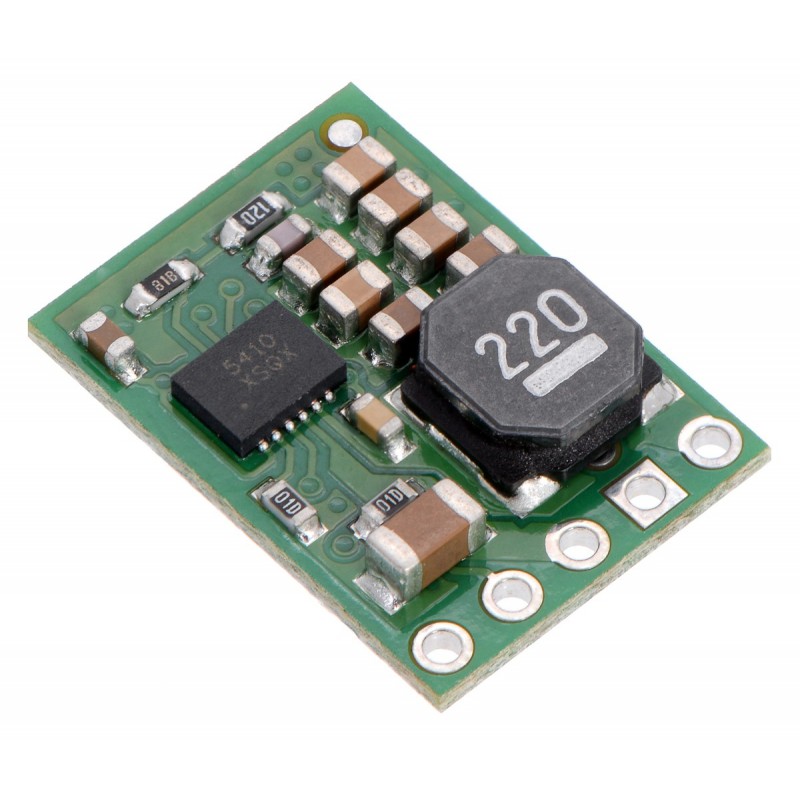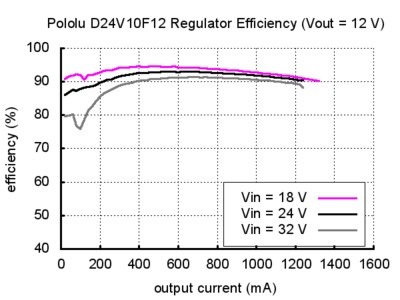

Pololu 12V, 1A Step-Down Voltage Regulator D24V10F12
The compact (0.5″ × 0.7″) D24V10F12 synchronous buck voltage regulator takes an input voltage of up to 36 V and efficiently reduces it to 12 V while allowing for a maximum output current of 1 A. This regulator offers typical efficiencies between 85% and 93% and has a very low dropout, so it can be used with input voltages as low as a few hundred millivolts above 12 V. The pins have a 0.1″ spacing, making this board compatible with standard solderless breadboards and perfboards.
Description
The D24V10Fx family of step-down voltage regulators features the Intersil ISL85410 1A synchronous buck regulator and generates lower output voltages from input voltages as high as 36 V. They are switching regulators (also called switched-mode power supplies (SMPS) or DC-to-DC converters) with typical efficiencies between 80% and 93%, which is much more efficient than linear voltage regulators, especially when the difference between the input and output voltage is large. These regulators have a power-save mode that activates at light loads and a low quiescent (no load) current draw, which make them well suited for applications that are run from a battery.
The different versions of this regulator all look very similar, so the bottom silkscreen includes a blank space where you can add your own distinguishing marks or labels. This product page applies to all five versions of the D24V10Fx family.
The SHDN pin can be used to put the board in a low-power state that reduces the quiescent current to approximately 10 µA to 20 µA per volt on VIN, and a PG (power good) output can be used to monitor the state of the regulator’s output voltage.
The regulators feature short-circuit/over-current protection, and thermal shutdown helps prevent damage from overheating. The boards do not have reverse-voltage protection.
Features
Connections
The buck regulator has five connections: power good (PG). shutdown (SHDN), input voltage (VIN), ground (GND), and output voltage (VOUT).
The “power good” indicator, PG, is an open-drain output that drives low when the regulator’s output voltage falls below 80% or rises above 120% of its target output voltage. This output is also actively held low for the duration of the regulator’s 2 ms soft-start period and while the regulator is being disabled by the SHDN input or by over-temperature or over-current fault conditions. An external pull-up resistor is generally required to use this pin.
The SHDN pin can be driven low (under 0.4 V) to turn off the output and put the board into a low-power state. There is a 100 kΩ pull-up resistor between the SHDN pin and VIN, so if you want to leave the board permanently enabled, the SHDN pin can be left disconnected. While the SHDN pin is being driven low, the current draw of the regulator is dominated by the current through the pull-up resistor and will be proportional to the input voltage. (At 36 V in it will draw about 360 μA.)
The input voltage, VIN, powers the regulator. Voltages between 3 V and 36 V can be applied to VIN, but the effective lower limit of VIN is VOUT plus the regulator’s dropout voltage, which varies approximately linearly with the load (see below for graphs of dropout voltages as a function of the load). Additionally, please be wary of destructive LC spikes (see below for more information).
The output voltage, VOUT, is fixed and depends on the regulator version: the D24V10F3 version outputs 3.3 V, the D24V10F5 version outputs 5 V, the D24V10F6 version outputs 6 V, the D24V10F9 version outputs 9 V, and the D24V10F12 version outputs 12 V.
The five connections are labeled on the back side of the PCB and are arranged with a 0.1″ spacing along the edge of the board for compatibility with solderless breadboards, connectors, and other prototyping arrangements that use a 0.1″ grid. You can solder wires directly to the board or solder in either the 5×1 straight male header strip or the 5×1 right-angle male header strip that is included.
Typical efficiency and output current
The efficiency of a voltage regulator, defined as (Power out)/(Power in), is an important measure of its performance, especially when battery life or heat are concerns. This family of switching regulators typically has an efficiency of 80% to 93%, though the actual efficiency in a given system depends on input voltage, output voltage, and output current. See the efficiency graph near the bottom of this page for more information.
In order to achieve a high efficiency at low loads, this regulator automatically goes into a power-save mode where the switching frequency is reduced. In power-save mode, the switching frequency of the regulator changes as necessary to minimize power loss. This could make it harder to filter out noise on the output caused by switching.
Typical dropout voltage
The dropout voltage of a step-down regulator is the minimum amount by which the input voltage must exceed the regulator’s target output voltage in order to ensure the target output can be achieved. For example, if a 5 V regulator has a 1 V dropout voltage, the input must be at least 6 V to ensure the output is the full 5 V. Generally speaking, the dropout voltage increases as the output current increases. See the “Details” section below for more information on the dropout voltage for this specific regulator version.
Details for item #2834
The graphs below show the typical efficiency and dropout voltage of the 12 V D24V10F12 regulator as a function of the output current:

.jpg)
Specifications
Download
Data sheet
Manufacturer BTC Korporacja sp. z o. o. Lwowska 5 05-120 Legionowo Poland sprzedaz@kamami.pl 22 767 36 20
Responsible person BTC Korporacja sp. z o. o. Lwowska 5 05-120 Legionowo Poland sprzedaz@kamami.pl 22 767 36 20
Step-Down DC-DC converter module based on the D36V6F12 system. Input voltage 12.2.50V, output voltage 12V (max. 600mA). Pololu 3796
Step-Down converter with an output voltage of 5 V, input voltage from 9 to 36 V and a maximum current of 5 A. The board is equipped with a DC input connector and an output USB connector
No product available!
DFRobot DFR0205 is a compact and efficient step-down DC-DC converter module with up to 25 W of power, allowing adjustment of the supply voltage to meet the needs of various electronic components. With a voltage regulation function, a quick 5 V selection switch, and an Ovout interface, it enables simultaneous power delivery to components with different voltage requirements. Ideal for prototyping, mobile projects, automation systems, and IoT applications.
Buck-mode DC-DC power module that converts voltage from 8 V to 28 V to a stable 5 V at a maximum current of 1.6 A, providing high conversion efficiency. Thanks to its small size, stability and reliability, the module is perfect for DIY projects, mobile power supply construction and applications requiring precise, stable voltage. DFRobot DFR0571
Efficient step-down converter that reduces the input voltage from up to 45 V to a regulated output voltage range from 1.4 to 7 V, offering high efficiency and a maximum continuous current of 3.4 A. It has built-in protection against reverse polarity, overload and short circuit, and the spread spectrum function reduces EMI interference. The module is equipped with an additional potentiometer for adjusting the cut-off voltage. Pololu 4872
DC-DC step-down converter module 12V 12A used to convert energy from 15-24V input voltage to stable 12V, providing up to 12A current. Thanks to high conversion efficiency (over 90%) and low ripple (<50mV), it is ideal for powering sensitive devices in applications such as robotics, drones or LED lighting systems. Additionally, built-in overheating and short-circuit protection mechanisms ensure reliable operation even in difficult conditions. DFRobot DFR1208
This small synchronous switching step-down (or buck) regulator takes an input voltage of up to 38 V and efficiently reduces it to 3.3 V. The board measures only 0.7″ × 0.7″, but it allows a typical continuous output current of up to 2.5 A. Typical efficiencies of 80% to 95% make this regulator well suited for powering moderate loads like sensors or small motors.
No product available!
Step-Down converter D36V50F9 with an output voltage of 9 V, an input voltage from 9.9 to 50 V and a maximum output current of 7 A. Pololu 4094
No product available!
Step-Down DC-DC converter module based on the D24V150F9 chip. Input voltage 11 ... 40V, output voltage 9V (max 15A). Pololu 2884
The Step Down DC-DC converter module (MP2307) allows to obtain 0.93..18V output voltage at 4.75..24V input voltage. The output voltage is regulated by a potentiometer
The Step-Down D24V6F3 Buck Voltage Regulator module gives the output voltage of 3.3V with a wide input voltage range of 4.8-42V and a maximum output current of 600 mA. Pololu 2106
The compact (0.4″ × 0.5″) D24V5F9 synchronous buck voltage regulator takes an input voltage of up to 36 V and efficiently reduces it to 9 V while allowing for a maximum output current of 500 mA. Pololu 2845
No product available!
The Step-Down D24V6AHV Buck Voltage Regulator module with adjustable output voltage in the range of 4-25V with a wide input voltage range of 4.5-42V and a maximum output current of 600 mA. Pololu 2104
No product available!
Step-Down converter D36V50F5 with an output voltage of 5 V, an input voltage from 5.5 to 50 V and a maximum output current of 8 A. Pololu 4091
Step-Down converter with an output voltage of 5 V, input voltage from 4.5 to 40 V and a maximum current of 2 A. The board is equipped with a segment LED display and a USB output
This small synchronous switching step-down (or buck) regulator takes an input voltage of up to 38 V and efficiently reduces it to 7.5 V. The board measures only 0.7″ × 0.7″, but it allows a typical continuous output current of up to 2.5 A. Typical efficiencies of 85% to 95% make this regulator well suited for powering moderate loads like sensors or small motors.
An efficient step-down converter that reduces the input voltage to 12 V at a maximum current of 100 mA, offering high efficiency due to low quiescent current (<50 μA). It supports input voltage from 12 V to 65 V, has a Power Good (PGOOD) function, an EN input for system shutdown, and short circuit and overheat protection, making it a reliable and energy-efficient solution. Pololu 5377
No product available!

Pololu 2834
